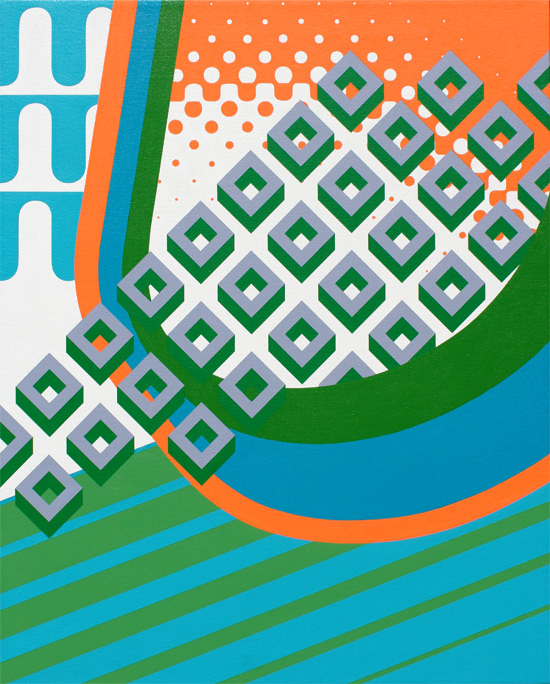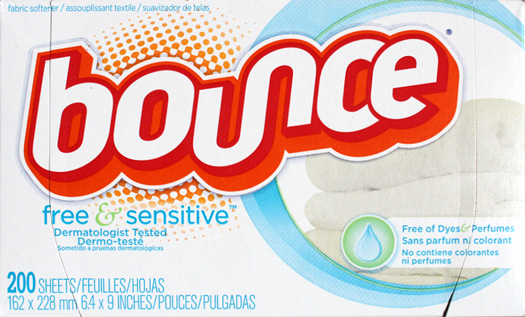What could the conveyance of visual energy, a magpie sampling aesthetic, and reclaimed stretcher bars possibly have in common? These are all things I have been thinking about as I have produced my newest painting, Stop Static (Before It Stops You).

Stop Static (Before It Stops You). Acrylic on canvas. 30 by 24 inches (76 x 61 centimeters). Commenced on the afternoon of Tuesday, February 25, 2014. Deemed complete on the afternoon of Saturday, March 8, 2014.
The primary inspiration — my starting point — for this painting is a simple box of Bounce fabric softener, an everyday object with a design that has captured my imagination for years. I love Bounce’s logotype, especially its double outlines and undulating, interlocking shapes. You may note how the lower left curve in the logotype’s “B” forms the striped motif in the upper right quadrant of the composition. What’s more, the fluorescent orange halftone pattern in the painting echoes the halftone on the box, shown below.

A box of Bounce: What started everything for this painting.
In honor of the inspiration for this painting, I originally considered naming this piece Bounce Rate. This title could have been a nod to my experience in web content consulting. “Bounce rate” is a metric of web visitors who leave a site within five seconds of arriving; they “bounce,” in effect. Yet, I wanted to push this idea further, so I searched for figures of speech involving the word “bounce.” While that proved fruitless, I soon stumbled upon a Bounce fabric softener ad campaign from the 1990s, which had the memorable tagline “Bounce Stops Static Before Static Stops You.”
Conveying visual energy
Considering this tagline at length, and reflecting further upon what this painting represents to me, I adjusted the painting’s title again, to Stop Static (Before It Stops You). The reworked phrase sounds more like a suggestion — to keep oneself from staying still, and continue to move forward, to keep growing. The painting can serve as a visual reminder to avoid falling into ruts in day-to-day life.
I found that the new title had much in common with a central idea that I have been developing about my paintings, as a whole — that they are conveyances of visual energy. This idea came to me when one of my patrons wrote to me about some of my framed prints, which he displays in his office:
Every day [the prints] inspire me to try to pretend to be the kind of person who approaches the world with the energy and color jumping out of those little squares.
What immediately struck me about this sentence is the word energy. This is what my paintings are all about! The experience of feeling energy is what I want my paintings — especially my maximal paintings — to embody. Energy is what I want to convey through my work.
A sampling aesthetic: Merging my favorite graphical motifs
Without question, this painting is very much an homage to — and an energetic collision involving — graphical elements that fascinate me.
In addition to Bounce-inspired stripes and a classic halftone pattern (I have always loved halftones, and can never get enough of them), Stop Static also incorporates a heraldic vair ancient pattern (found in the upper left corner of the painting), and stripes of decreasing widths (another favorite motif).
Yet, the “star” graphical element is a rising diamond pattern — called “diamond haze,” I believe — by Diane von Furstenberg. For years I have admired this pattern, and have wanted to incorporate it into a composition.
von Furstenberg’s current exhibition at the Wilshire May Company Building in Los Angeles, The Journey of a Dress, has offered a perfect occasion to do so. The diamond haze pattern can be found on many of von Furstenberg’s signature wrap dresses. It also adds a visual rhythm to the walls and the floors of the exhibition. This is a classic and timeless pattern. It’s so perfect that I wish I had developed it myself. Bringing it into my work — much like sampling in music — is a way of paying tribute.
Although this painting is very much an amalgam of my favorite things, in terms of graphic motifs, ultimately I believe that this painting asks to be seen on its own terms, free of the context I just offered. There is no narrative to be had here. There is nothing to get. This painting affords a purely visual experience — and I hope it’s an energizing one, at that.
The role of “reclaimed” stretcher bars
The stretcher bars supporting this canvas are literally more than 15 years old (from the late 1990s), and recall a time when I was first learning how to paint. The bars were originally part of a pre-stretched canvas that I acquired from a store. (I haven’t purchase pre-stretched canvas in years! So much has changed.)
The painting I attempted to make on the pre-stretched canvas never got anywhere. I abandoned it, and left it in my dad’s house, where I stored many of my early works, along with my mom’s paintings.
In attempt to clear out his house, my dad recently returned to me several half-finished canvases and untouched canvas panels. What is this?, I thought, when he handed me one canvas after another. It was so hard to look at my early work! It’s awful stuff, to be honest. I struggled mightily to paint back then, and it’s evident in my brushwork.
Back at my studio, seeing this pile of old, half-finished pieces every day was a drain on my energy. Taking the canvases off the bars and rolling them up helped clear my mind.
Left with the bare stretcher bars, I realized that I had an opportunity to start over — returning to the past, building upon the past, and being reminded of how far I’ve come in 15 years. What’s more, I could make this new painting at an out-of-pocket cost of zero, using canvas, gesso, and paint that I already had in inventory. In effect, I had nothing to lose!
In the end, it was a joy to make this painting, and I hope this enjoyment comes through in my work. There were several times along the way, as I painted this piece, when I reflected on how thankful I am to be able to paint. Painting really does give me pleasure. It’s often not easy work, at all, but the rewards are profound.